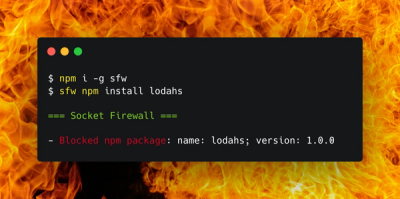
Product
Introducing Socket Firewall: Free, Proactive Protection for Your Software Supply Chain
Socket Firewall is a free tool that blocks malicious packages at install time, giving developers proactive protection against rising supply chain attacks.
horse is a couple of helper classes that can be used to help you build isomorphic applications for io.js / node. It abstracts routing and rendering helpers so that you can plug in a rendering system, bind links, and have an application that works anywhere.
The vast bulk of your application will live in your routes file (routes.jsx
in the example below), your API library, and your views - and will be shared
between the server and the client. horse's job is to get out of the way so that
you don't care where the code is running, and yet you get both server-side and
client-side rendering.
======================================
Your App
+---------+ +---------------+
| koa | | html5 history |
+---------+ | api |
| +---------------+
req req
| | render and
\ / wait for new route
------------------------ event
| ^
v |
====================================== |
+--------------+ |
| horse/App.js | |
+--------------+ |
| |
v |
==================================== |
Your App's Routes |
|
+---------------+ |
| route handler | -> yield { body: reactElement }
| | -> throw MissingAuthenticationError();
+---------------+
The App has an instance of an Express-like request router that it uses to map requests to the appropriate handling function, and is run on both the client- and server- side. It's meant to abstract just enough boilerplate out of the way so that you can do your own custom stuff.
An example usage might be like: (es6 incoming)
routes.jsx
// This is used both client- and server- side, and simply sets up an app with
// routes; in this case, returning React elements.
import Layout from '../layouts/layout.jsx';
import Index from '../pages/index.jsx';
function setupRoutes(app) {
app.router.get('/', function *() {
this.layout = Layout;
var user = yield db.getUser(1);
this.props = { user };
this.body = <Index {...this.props} />;
});
}
export default setupRoutes;
server.es6.js
import koa from 'koa';
import React from 'react';
import {App} from 'horse';
import setupRoutes from './setupRoutes';
var server = koa();
var app = new App();
setupRoutes(app);
server.use(function *(next) {
yield app.route(this, function () {
var Layout = this.layout;
this.body = react.renderToStaticMarkup(
<Layout>{this.body}</Layout>
);
});
}
client.es6.js
import React from 'react';
import {ClientApp} from 'horse';
import setupRoutes from './setupRoutes';
import jQuery as $ from 'jquery';
var app = new ClientApp();
setupRoutes(app);
var $mountPoint = document.getElementById('app-container');
$(function() {
$('body').on('click', 'a', function(e) {
var $link = $(this);
var ctx = app.buildContext($link.attr('href'));
yield app.route(ctx);
React.render(ctx.body, $mountPoint);
});
});
Default events:
app.on('route:start', function(ctx){})
app.on('route:end', function(ctx){})
app.on('route:end', function(error, ctx, app){})
You can also add an array of request start / end functions that operate per request, instead of globally on the app:
app.startRequest.push(function(app, server) {
if (server) { console.log('started on the server'); }
});
app.endRequest.push(function(app, server) {
if (server) { console.log('started on the server'); }
});
ignore npm and add .es6.js to the transpiled files, like
so:require('babel/register')({
ignore: false,
only: /.+(?:(?:\.es6\.js)|(?:.jsx))$/,
extensions: ['.js', '.es6.js', '.jsx' ],
sourceMap: true,
});
FAQs
isomorphic app core
The npm package @r/horse receives a total of 0 weekly downloads. As such, @r/horse popularity was classified as not popular.
We found that @r/horse demonstrated a not healthy version release cadence and project activity because the last version was released a year ago. It has 4 open source maintainers collaborating on the project.
Did you know?

Socket for GitHub automatically highlights issues in each pull request and monitors the health of all your open source dependencies. Discover the contents of your packages and block harmful activity before you install or update your dependencies.

Product
Socket Firewall is a free tool that blocks malicious packages at install time, giving developers proactive protection against rising supply chain attacks.

Research
Socket uncovers malicious Rust crates impersonating fast_log to steal Solana and Ethereum wallet keys from source code.

Research
A malicious package uses a QR code as steganography in an innovative technique.